Firebase Studio : Our complete review (+5 alternatives)
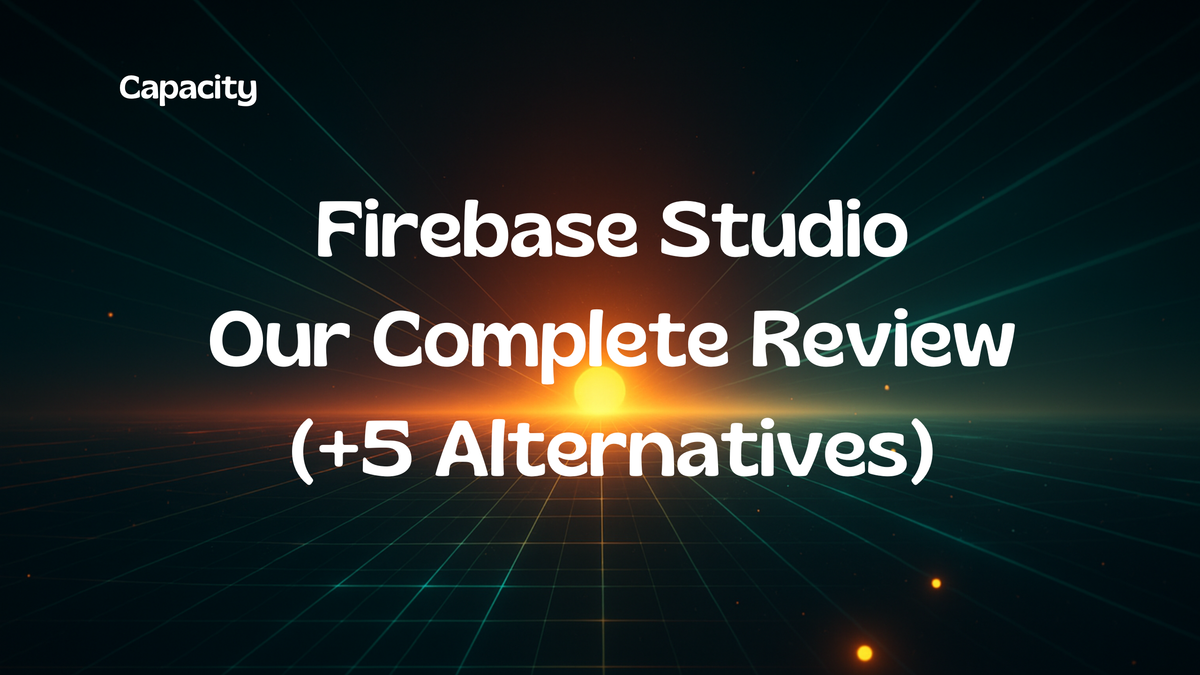
In the dynamic world of application development, Google has introduced Firebase Studio, a groundbreaking cloud-based development environment. This tool is ideal for developers aiming to create full-stack web and mobile applications effortlessly while incorporating cutting-edge AI technology. Recently launched, Firebase Studio combines AI-driven prototyping, seamless Google Cloud integration, and a suite of features designed to streamline the development process for maximum efficiency.
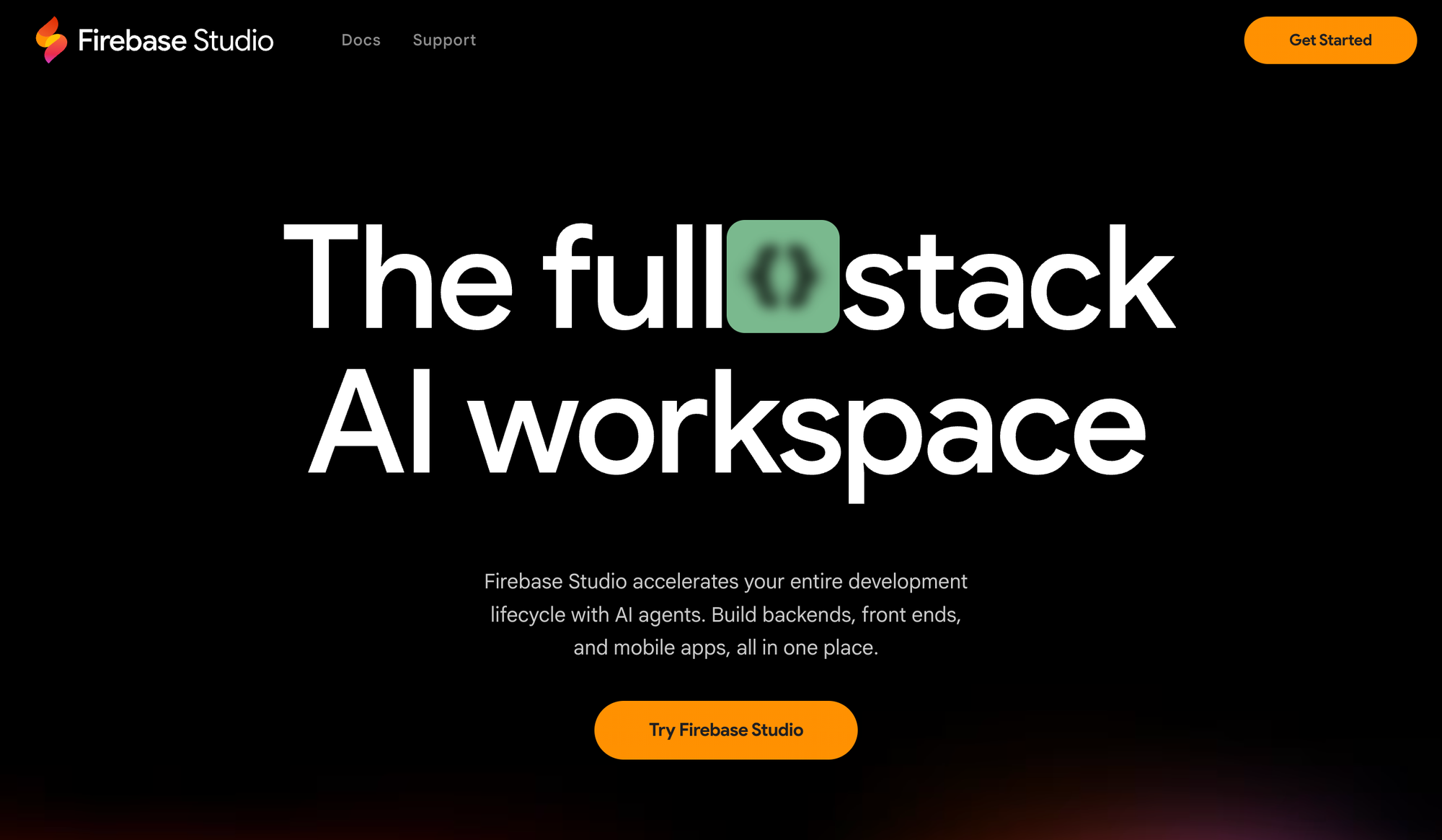
Firebase Studio caters to both experienced developers and beginners, offering versatile tools that adapt to diverse coding styles. Among its innovative features is the 'vibe coding' approach, which empowers developers to build functional web apps using natural language, images, or even sketches. This accessibility broadens its appeal to a wider audience. In this article, we’ll explore Firebase Studio’s functionalities, usage, pricing, advantages, disadvantages, and alternative solutions, helping you determine if it's the perfect fit for your development projects.
What is Firebase Studio?
Firebase Studio is a comprehensive, cloud-based development environment designed to streamline and enhance the entire app development lifecycle. It integrates the powerful capabilities of Firebase services with Google's Gemini AI technology, creating a seamless and highly efficient development experience.
One of its standout features is AI-Driven Prototyping. The App Prototyping agent enables developers to quickly generate functional web app prototypes using multimodal prompts, including natural language, images, and drawing tools. Supporting popular frameworks like Next.js, developers can describe their app idea and receive a generated app blueprint, code, and a web preview through a streamlined no-code development flow.
Firebase Studio also offers a rich library of Ready-to-Use Templates and sample apps in various languages and frameworks, such as Go, Java, Node.js, React, Flutter, and more. These templates help developers start quickly, reducing the time and effort needed to set up new projects.
The platform integrates deeply with Firebase Services, enabling developers to connect easily with features like Firestore, Auth, Realtime Database, Cloud Functions, and Hosting. This integration ensures that backend services, hosting, and other development aspects are managed within a cohesive environment.
Additionally, Firebase Studio provides Real-Time Collaboration capabilities. Developers can share their development environment via a URL, allowing team members to collaborate in real-time within the same workspace. This feature enhances teamwork and accelerates the development process.
The environment is highly Customizable, with support for Nix and a flexible code editor based on Code OSS. This adaptability allows developers to tailor their workspace to their specific needs and preferences.
Firebase Studio simplifies deployment with One-Click App Deployment. Developers can easily publish their apps using Firebase Hosting, which handles the build, CDN, and server-side rendering, ensuring a smooth and efficient deployment experience.
Moreover, Firebase Studio supports Flexible Coding Modes, allowing developers to build apps either by writing code or using simple text prompts. This versatility caters to different coding styles and preferences, making the platform accessible to a wide range of developers.
How to Use Firebase Studio
To get started with Firebase Studio, the process is relatively straightforward and user-friendly, even for those new to cloud-based development environments. Here’s a step-by-step guide on how to use Firebase Studio effectively:
Accessing Firebase Studio
You can access Firebase Studio by visiting the official website at studio.firebase.google.com. All you need is a Google account to sign in and begin using the platform.
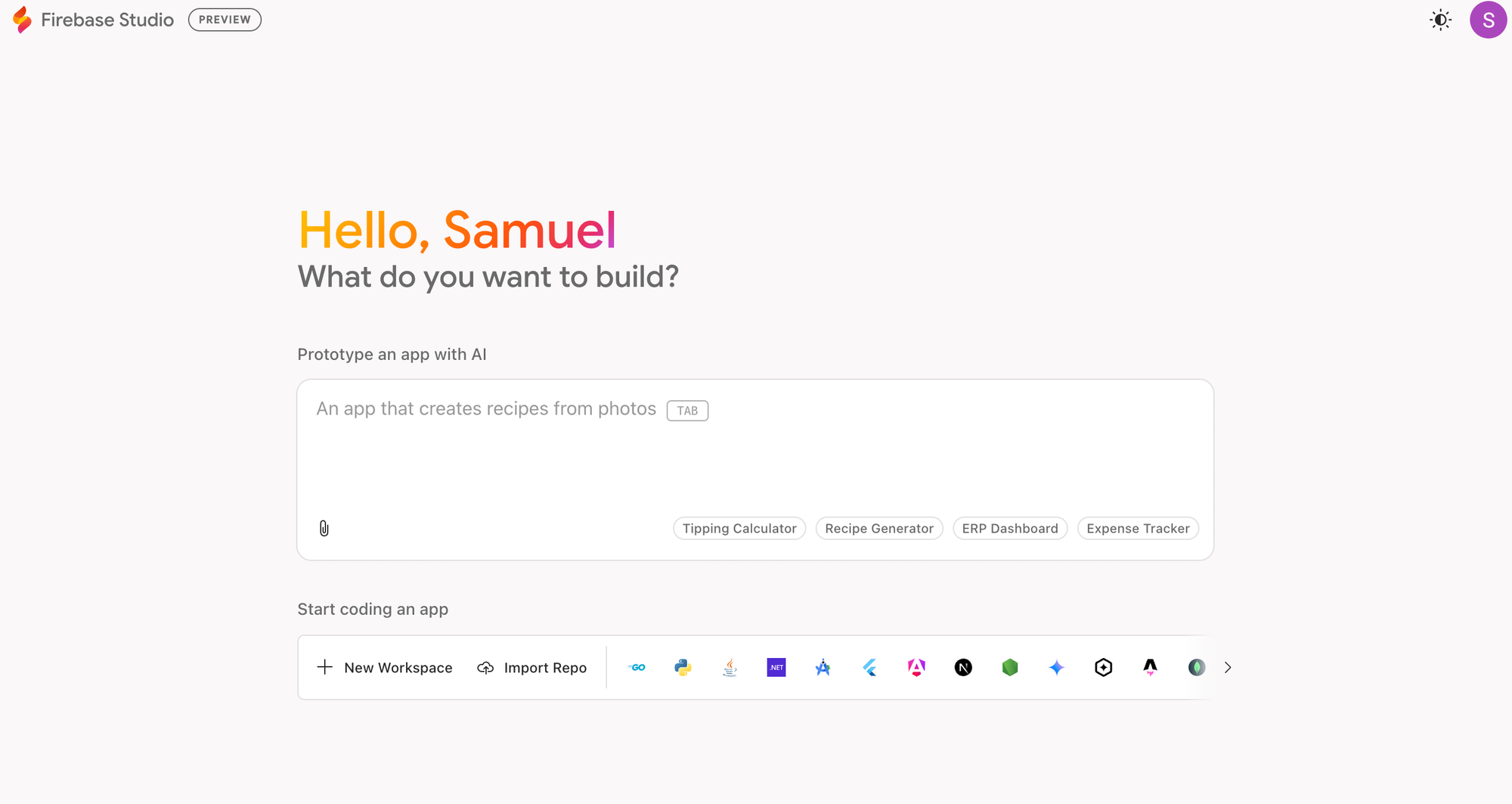
Creating a New Project
Once you're logged in, you can create a new project by typing a prompt that describes the app you want to build. Firebase Studio uses AI to generate a ready-to-run project based on your description, leveraging Firebase’s tools and services under the hood.
This process is particularly useful for rapid prototyping and getting a functional app up and running quickly.
Setting Up Your Workspace
After creating your project, you'll be taken to your workspace where you can see the generated code and app structure. Firebase Studio supports various frameworks and languages, so you can choose the one that best fits your needs.
The workspace is also customizable, allowing you to adjust the code editor and other settings to your preference.
Integrating with Firebase Services
Firebase Studio is tightly integrated with other Firebase services such as Firestore, Auth, Realtime Database, Cloud Functions, and Hosting. You can easily connect these services to your app within the Firebase Studio environment, ensuring a seamless development and deployment process.
Using AI Agents for Automation
Firebase Studio allows you to leverage AI agents, such as those from n8n, to automate backend actions and workflows. With these tools, you can set up webhooks, process data, and generate responses efficiently. This functionality can significantly streamline your development workflow.
Collaborating with Team Members
The platform supports real-time collaboration, enabling you to share your development environment with team members via a URL. This feature enhances teamwork and accelerates the development process by allowing multiple developers to work on the same project simultaneously.
Deploying Your App
Once your app is ready, Firebase Studio simplifies deployment with its one-click app deployment feature. You can publish your app using Firebase Hosting, which handles the build, CDN, and server-side rendering, ensuring a smooth and efficient deployment experience.
Pricing - Evaluating the Cost
When considering Firebase Studio for your development needs, understanding the pricing model is important to evaluate the overall cost and ensure it aligns with your budget.
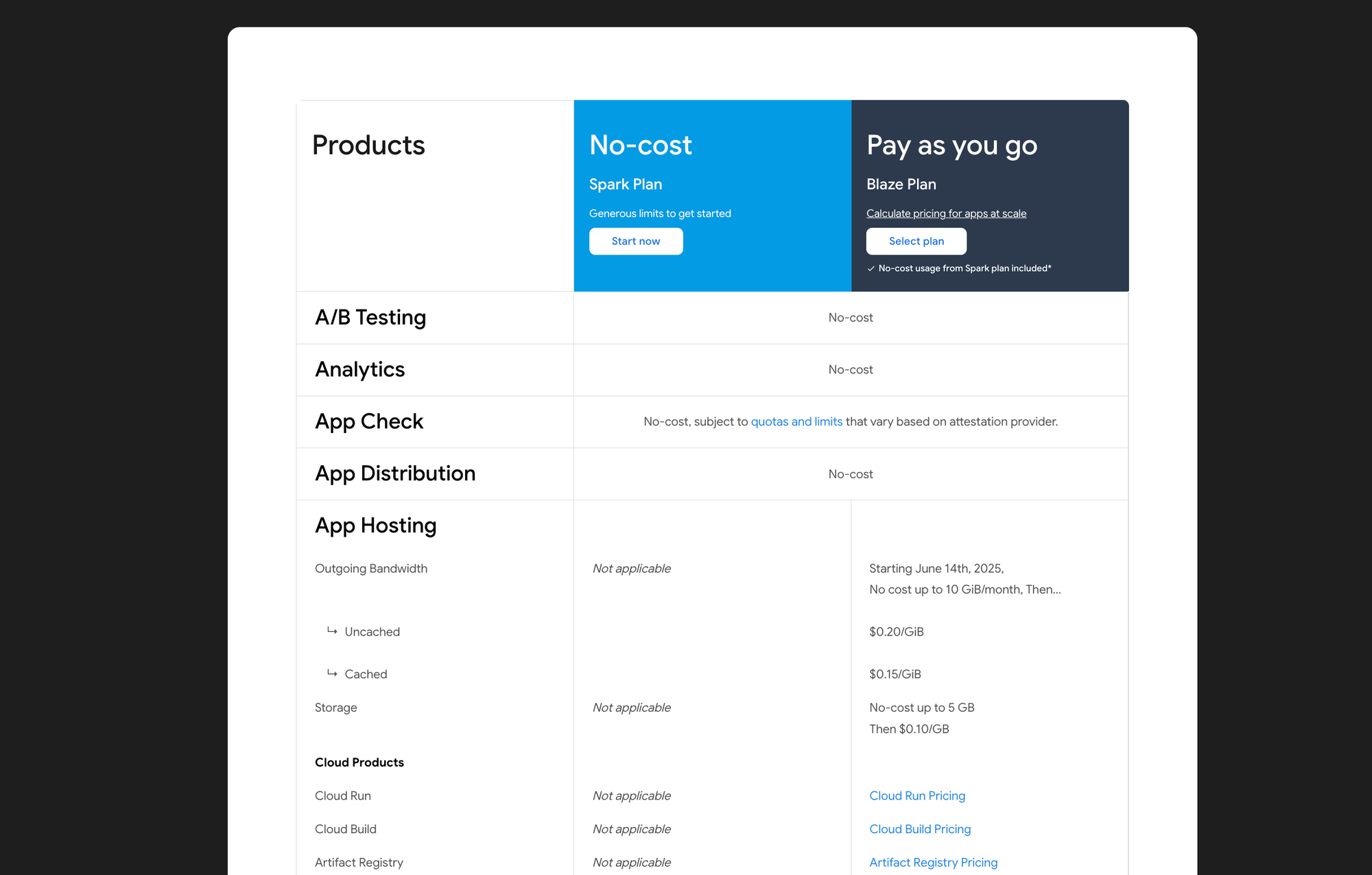
Here’s a breakdown of the current pricing structure for Firebase Studio:
Free Tier (Preview Access)
Firebase Studio is currently available in a preview phase, offering a free tier with limited but useful features. Users can access up to 3 workspaces at no cost. Members of the Google Developer Program can enjoy up to 10 workspaces, while Premium members of the program can use up to 30 workspaces.
Standard and Premium Plans
Beyond the free tier, Firebase Studio offers a Standard Plan and a Premium Plan. The Standard Plan is free and includes up to 10 workspaces. The Premium Plan, priced at $299 per year, provides 30 workspaces along with additional AI perks and features.
Enterprise Plan
For larger organizations and teams working on advanced, large-scale projects, Firebase Studio offers an Enterprise Plan. This custom-priced plan includes unlimited workspaces and advanced features, making it suitable for extensive development needs.
Additional Costs: Firebase Services and Hosting
While using Firebase Studio itself may be free or low-cost, there are other potential costs to consider. Deploying your app using Firebase App Hosting requires a linked billing account, which transitions your project to the Blaze (pay-as-you-go) plan. Charges are incurred based on the usage of various Firebase services such as Firestore, Cloud Functions, and Cloud Storage. These services have free usage quotas but will generate costs once the limits are exceeded.
Gemini API Usage
If you use Gemini for AI assistance beyond the free tier, you may face additional charges. This is particularly relevant for Google Workspace users who require a valid Gemini Code Assist subscription. It's important to keep track of your Gemini API usage to prevent unexpected expenses.
By familiarizing yourself with these pricing details, you can effectively plan your development budget and ensure that Firebase Studio continues to be a cost-efficient choice for your app development requirements.
Firebase Studio: Pros and Cons
As with any development tool, Firebase Studio has its strengths and weaknesses. Here’s a detailed look at the pros and cons to help you make an informed decision.
Pros
Reduced Friction and Streamlined Development
Firebase Studio is designed to reduce friction in the development process. It offers an intuitive layout that allows developers to spend less time navigating and more time building. The interface is workflow-oriented, making it easier to transition between tasks such as building, testing, deploying, and monitoring.
Enhanced Visibility and Cross-Service Insights
The platform provides holistic project health overviews and better cross-service insights. For example, you can see which Cloud Function is causing high Firestore reads, all within integrated monitoring dashboards. This enhanced visibility helps in identifying and resolving issues more efficiently.
Improved Collaboration
Firebase Studio enhances team collaboration with clearer views and better role management, leveraging Google Cloud IAM. This makes it easier for team members to work together on projects, share workspaces, and provide real-time feedback.
Simplified Onboarding and Training
The guided, workflow-oriented approach of Firebase Studio makes it easier for newcomers to understand and utilize the full power of Firebase. It also democratizes access to application development, enabling beginners to create sophisticated projects while learning.
Cost Efficiency and Scalability
Firebase Studio, along with Firebase services, offers cost efficiency through its pay-as-you-go model and scalable infrastructure. This allows developers to scale their applications without worrying about the underlying infrastructure.
Cons
Learning Curve for Advanced Features
While Firebase Studio simplifies many aspects of app development, mastering its advanced features, especially those involving AI and integration with other Firebase services, can require a significant learning curve. This might be a barrier for developers who are new to these technologies.
Dependence on Google Ecosystem
Firebase Studio is tightly integrated with the Google Cloud ecosystem, which can be both a benefit and a drawback. Developers who prefer or are required to use other cloud services might find this integration limiting.
Potential Costs Beyond Free Tier
While the free tier of Firebase Studio is generous, using certain features beyond this tier, such as extensive AI assistance or high usage of Firebase services, can incur additional costs. This needs to be carefully managed to avoid unexpected expenses.
Limited Customization in Some Areas
Although Firebase Studio offers a high degree of customization, some users might find certain aspects of the environment less flexible than they would like. For instance, the AI-driven prototyping, while powerful, may not always align perfectly with every developer's coding style or preferences.
By weighing these pros and cons, you can better determine whether Firebase Studio aligns with your development needs and preferences.
5 Alternatives to Firebase Studio
If Firebase Studio does not fully meet your development needs, there are several alternative platforms that offer unique features and benefits. Here are five notable alternatives to consider:
1. Capacity.so
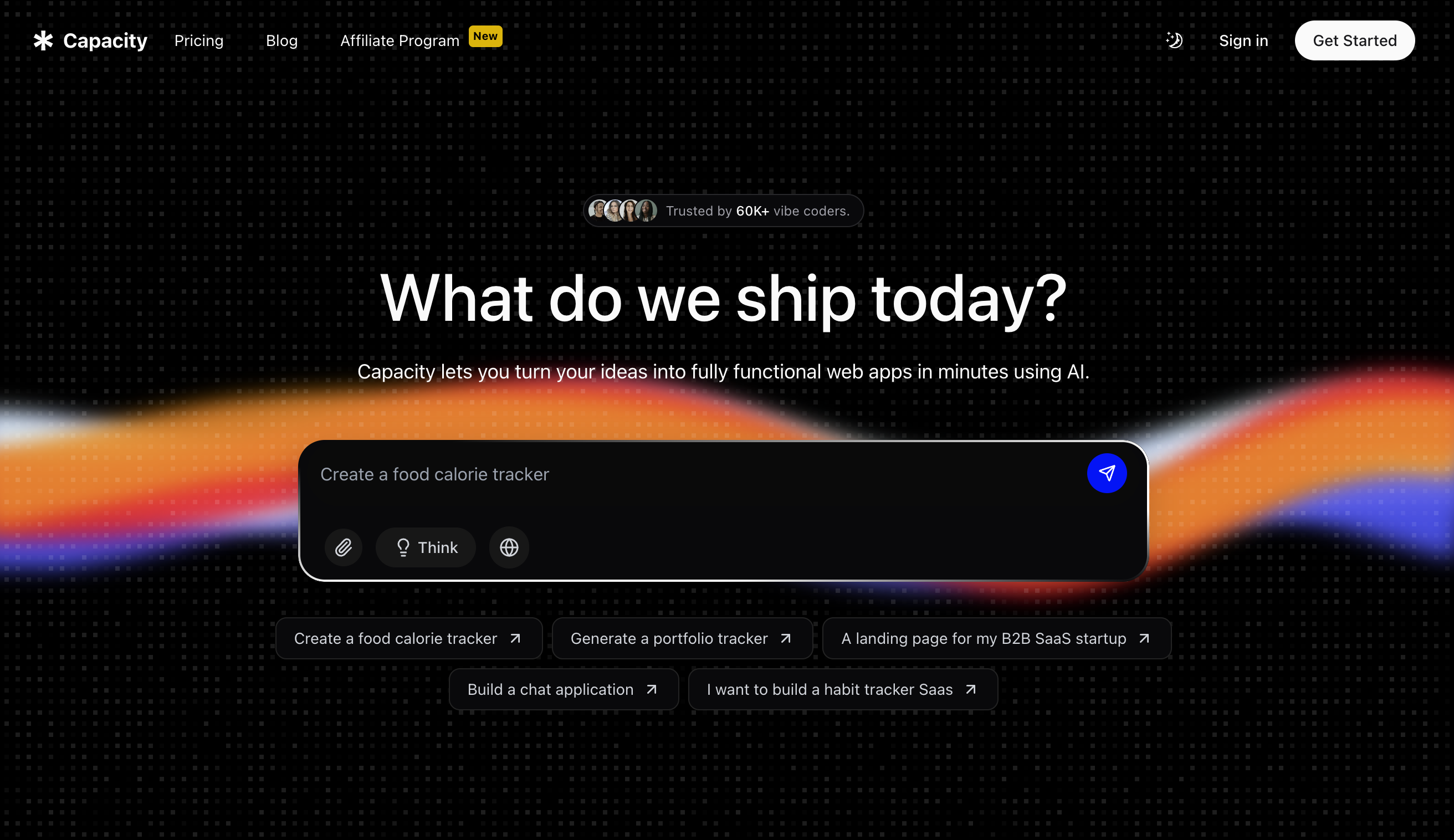
Capacity.so stands out as a strong alternative to Firebase Studio, particularly due to its robust backend features. It boasts powerful rollback functionalities that help prevent breaking changes, along with auto-healing features that ensure the stability of your application. One of the key advantages of Capacity.so is its use of better AI models compared to Gemini, which is used by Firebase Studio.
These advanced AI capabilities can significantly enhance the development process, making Capacity.so an attractive option for developers seeking more sophisticated AI-driven tools.
2. Lovable
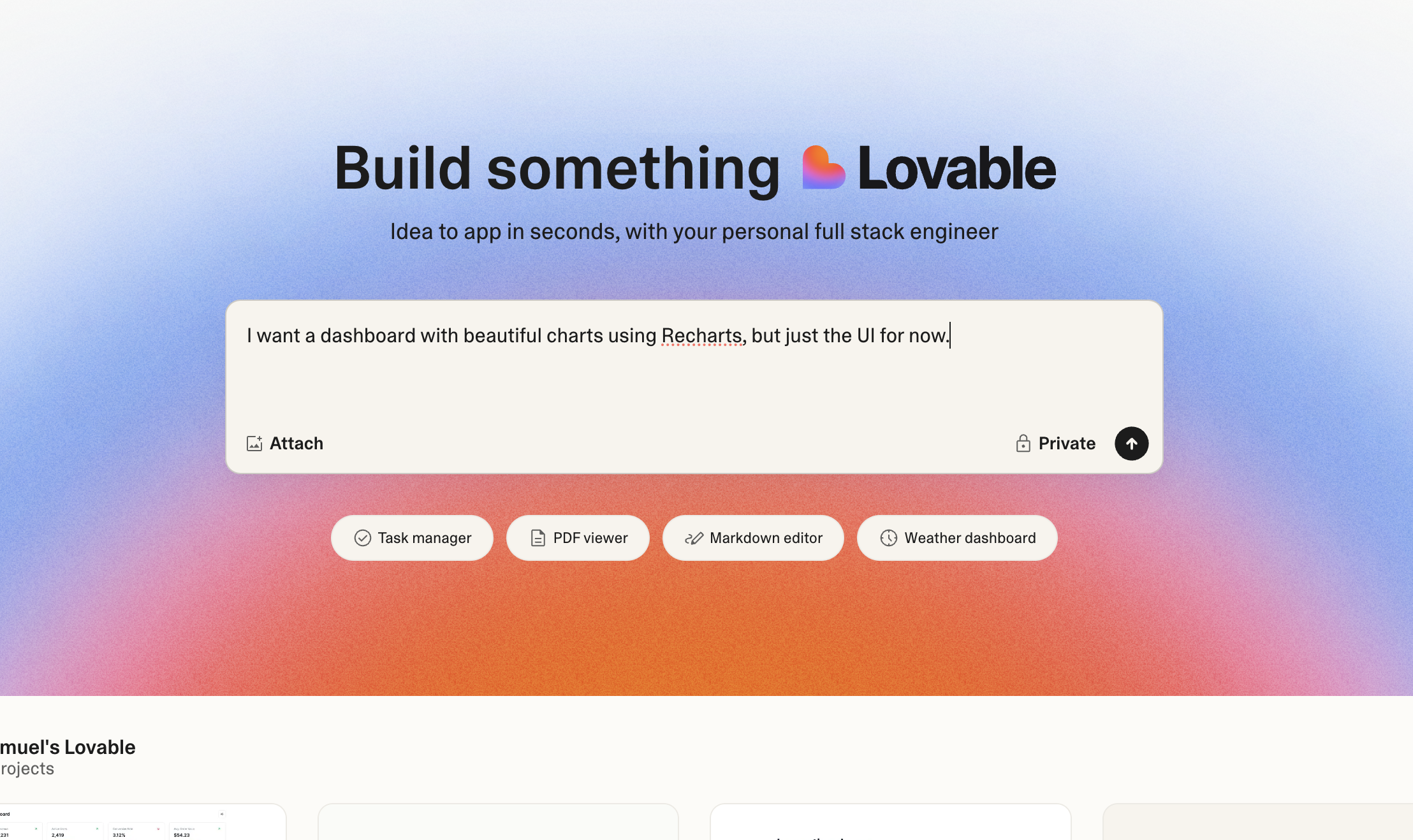
Lovable is another viable alternative that is user-friendly, especially for non-technical users. It offers a straightforward interface for building applications without the need for extensive coding knowledge. Lovable provides features such as data input forms, recommendation engines, and card displays, all of which can be configured easily.
This platform is ideal for those who prefer a more intuitive and less cluttered development environment compared to Firebase Studio.
3. Replit
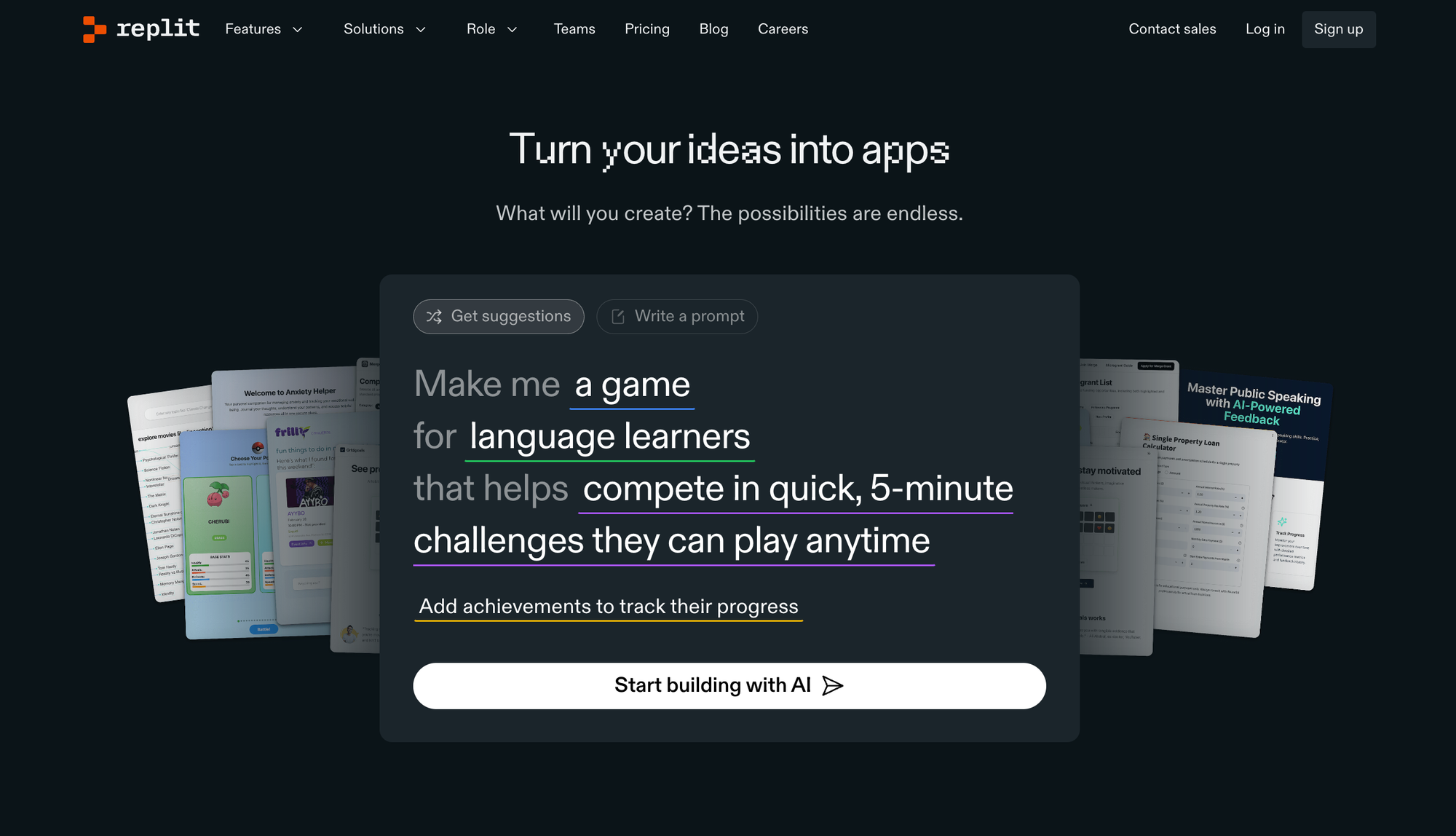
Replit is a cloud-based coding environment that offers a range of features suitable for both beginners and experienced developers. It supports multiple programming languages and frameworks, and it is known for its real-time collaboration capabilities.
Replit also integrates with various services and repositories, making it a versatile alternative to Firebase Studio. Its simplicity and ease of use make it an excellent choice for rapid prototyping and development.
4. v0

v0 is a platform that focuses on providing a token-based pricing model, which can be more cost-effective for certain types of projects. It supports faster database rendering using databases like MongoDB, Supabase, or Neon, which might not be available in the preview phase of Firebase Studio.
v0 also offers integration with payment gateways like Stripe, although its pricing structure can be complex and requires careful management to avoid unexpected costs.
5. Polymet.ai
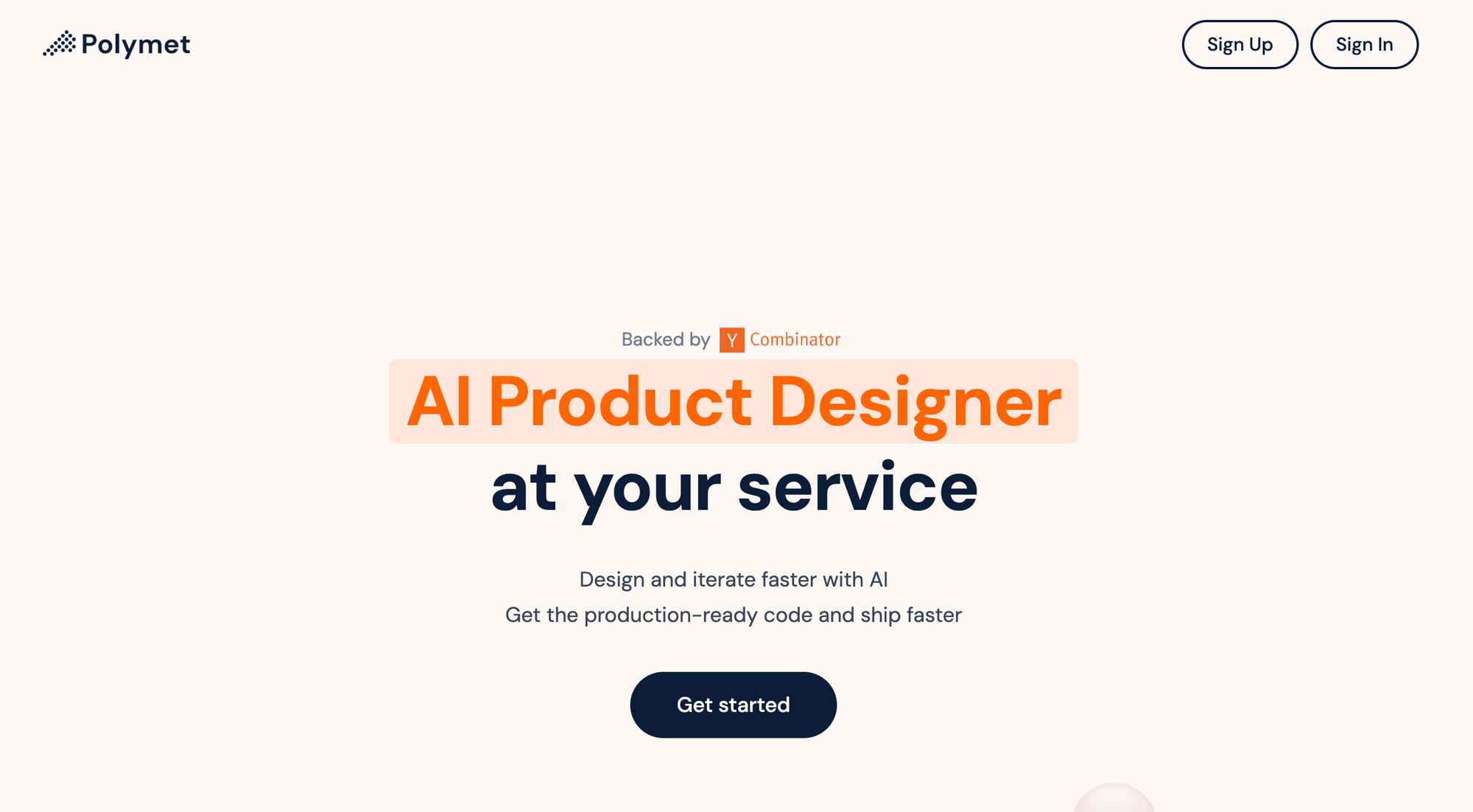
Polymet.ai is an AI-driven development platform designed to automate various aspects of the development process. It utilizes advanced AI models to assist with coding, debugging, and optimizing applications. This platform is especially beneficial for full-stack development, offering features such as automated code generation, real-time testing, and seamless deployment.
Polymet.ai is an excellent choice for developers aiming to leverage AI to streamline their workflows and boost productivity.
Each of these alternatives provides unique strengths and can be selected based on the specific requirements and preferences of your development project.
How to Choose the Right Tool for Your Needs
Choosing the right development tool is a critical decision, especially when factoring in the complexity of your project and your level of coding expertise. Below are some key considerations to help you decide between Firebase Studio and its alternatives:
Coding Expertise
If you lack extensive coding knowledge, tools like Capacity.so or Lovable might be more suitable. For instance, Capacity.so is recognized for its robust backend features and user-friendly interface, making it easier for non-technical users to build and manage applications. In contrast, Firebase Studio, while highly capable, has a more complex, developer-focused interface that may feel overwhelming for those without significant technical expertise.
Project Complexity
For complex projects requiring deep integration with various services and advanced AI capabilities, Firebase Studio might be the better choice. It provides seamless integration with the Google Cloud ecosystem, including Firebase services like Firestore, Auth, and Cloud Functions. However, this added complexity can make debugging and issue resolution more challenging compared to simpler alternatives.
Development Style
If you prefer a conversational and intuitive approach to development, Firebase Studio's App Prototyping Agent or Lovable could be ideal. These tools allow you to describe your app idea in natural language and quickly generate a functional prototype.
On the other hand, if you are comfortable working with templates and prefer a more structured development style, Firebase Studio's template option or Replit might be more appealing.
Collaboration and Scalability
For team projects or large-scale applications, it is essential to consider the collaboration features and scalability of the tool. Firebase Studio supports real-time collaboration and is well-suited for projects involving multiple developers.
Similarly, Replit and Capacity.so offer strong collaboration tools, making them ideal for team environments.
Cost and Resource Usage
Another key consideration is the cost and resource usage. Firebase Studio is free during its preview period; however, charges may apply if you exceed the free quotas for Firebase services or Gemini API usage. Capacity.so and other alternatives may offer different pricing structures, so it’s important to assess the costs based on your unique requirements and usage patterns.
By thoroughly evaluating these aspects, you can make a well-informed choice about the tool that best suits your development needs, skill level, and project goals.
Conclusion
Firebase Studio is a robust tool for app development, offering seamless integration with Google Cloud services, AI-driven prototyping capabilities, and a user-friendly interface. Despite its strengths, it’s important to consider its potential drawbacks, such as increased complexity and costs that may arise beyond the free tier.
Several alternatives, including Capacity.so, Lovable, Replit, v0, and Polymet.ai, offer distinct advantages. These platforms excel in areas like ease of use, performance, or customization, making them valuable options depending on your needs.
When deciding on a tool, take into account your coding expertise, the complexity of your project, and your specific requirements. By carefully evaluating these factors, you can identify the platform that best aligns with your goals, streamlining your development process and ensuring success. Explore these options to discover the perfect fit for your next project.
FAQ
What are the key features of Firebase Studio that accelerate the development lifecycle of full-stack apps?
Firebase Studio's key features include:
- AI-driven prototyping using natural language, images, or drawings
- Gemini integration for smart suggestions and debugging
- Ready-to-use templates in popular languages and frameworks
- Seamless Firebase integration with services like Firestore and Hosting
- Real-time collaboration
- A customizable development environment
- One-click app deployment with Firebase Hosting
How does Firebase Studio utilize AI agents to enhance the development process?
Firebase Studio utilizes AI agents through the App Prototyping agent, which employs generative AI to develop, test, and publish full-stack web apps. It generates app blueprints, code, and web previews using natural language, images, and drawing tools.
The studio also integrates Gemini APIs for AI-driven features and Genkit for custom AI workflows, simplifying coding tasks like debugging and refactoring with Gemini's assistance.
What deployment options are available in Firebase Studio for publishing and monitoring apps?
Firebase Studio offers several deployment options, including:
- Firebase App Hosting: For dynamic applications like Next.js and Angular, with GitHub integration and support for other Firebase services.
- Firebase Hosting: For hosting web apps, static content, and single-page apps, with a global CDN and custom domain support.
- Cloud Run: For deploying containerized, scalable, and portable applications.
- Other deployment options: Allowing deployment to other platforms or your own server.
Can I import existing projects into Firebase Studio, and if so, how?
Yes, you can import existing projects into Firebase Studio. Projects can be imported from GitHub, GitLab, Bitbucket, or your local machine.
During project creation, you can select the option to import from these sources or use custom templates tailored to your preferred tech stacks.
